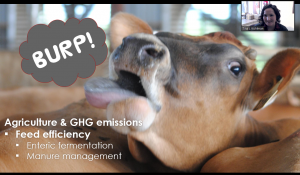Tina Kohlman, Regional Dairy and Livestock Agent
Reducing greenhouse gas emissions from all sectors of society, including the agriculture sector, is a concern for all. The agriculture sector contributes 10% of the greenhouse gas emissions, behind transportation, electricity, industry, and commercial and residential sources. Greenhouse gas emissions from the barn comes mainly from enteric (rumen) fermentation with other sources from soils and manure.
 In the recent 2022 CAFO Update virtual meeting, Regional Dairy Educators Tina Kohlman and Aerica Bjurstrom shared with participants potential feeding strategies to increase feed efficiency while reducing greenhouse gas emissions from the dairy cow.
In the recent 2022 CAFO Update virtual meeting, Regional Dairy Educators Tina Kohlman and Aerica Bjurstrom shared with participants potential feeding strategies to increase feed efficiency while reducing greenhouse gas emissions from the dairy cow.
Feed efficiency is a strategy to reduce greenhouse gas emissions. Cattle excrete 75 to 95 percent of their protein intake as urinary nitrogen which can volatilize as nitrous oxide. To reduce urinary nitrogen, cattle should not be fed over the recommended protein requirements for their stage of life or lactation. They could also be fed a higher energy-protein forage ratio or balance high protein forage diets with high-energy supplements.
The production of methane in the cow’s rumen is part of the natural process of digestion and fermentation. However, 96 percent of methane emissions from livestock comes for the cow and is released into the atmosphere through belching, or the burp. The best type of strategy to reduce enteric methane emissions is through feeding and nutrition. Feeding high-quality, highly digestible forages or grains enhances the levels of the volatile fatty acids propionate and decreases acetate, which can be used to produce methane. Grinding and pelleting of forages is another method, increasing the rate of passage through the rumen which decreases the opportunity for methane to be produced. Feed additives that block the or inhibit the formation of methane in the rumen (3NOP, red seaweed, nitrates, etc.) or rumen fermentation modifiers (tannins, ionophores, essential acids, etc.) that protect proteins in the rumen from use by less-desirable microbes, can reduce the production of methane as a by-product. Other approaches include removal of protozoa and other methanogens (methane producing microbes) from the rumen, encouragement of acetogenic bacteria to grow reducing the amount of available acetate and thus reducing methane production, or vaccinating cows to stimulate antibodies against the methanogens.
Regardless of the approach, one needs to take in consideration when feeding to reduce greenhouse gas emissions from cows: potential toxicity to the good rumen microbe population, possible toxicity to the cow, decrease in milk production and/or animal health, cost of product and return on investment, availability of product, and method of delivery to the cow.
Much additional research needs to be done in strategies to reduce enteric methane and other greenhouse gas emissions from the cow without sacrificing milk production, cow health, dairy product integrity, while being financial viable. What we do know, if we can increase rumen efficiency and performance by improving feed efficiency, more nutrients will go into the production of milk and meat and less wasted into the atmosphere as greenhouse gases.




